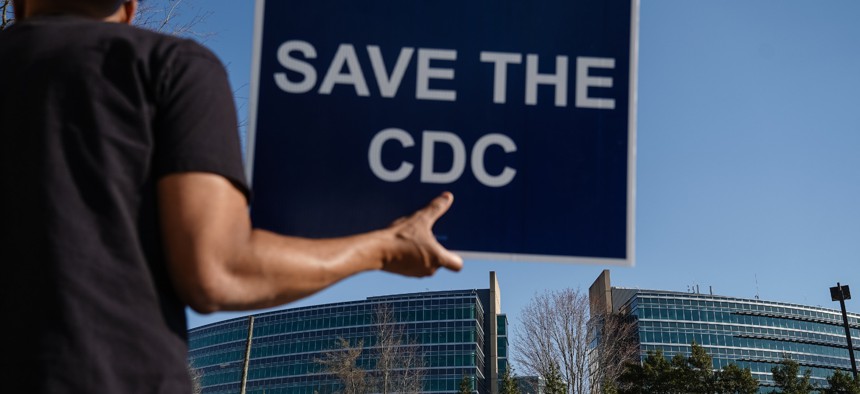
People protesting personnel cuts at the Centers for Disease Control hold signs outside the organization's main headquarters on March 12, 2025 in Atlanta, Georgia. Elijah Nouvelage / Getty Images
CDC has shed one-quarter of staff even as it recalls some laid off workers
Agency tells court that states are not suffering "irreparable harm" from cuts even as agency leaders lament "operational disruptions" and "loss of expertise and capacity."
The Centers for Disease Control and Prevention has shed nearly one-quarter of its staff since President Trump took office, with nearly 3,000 employees leaving the agency either involuntarily or on their own accord.
The cuts have dramatically reshaped the agency, leadership said during a town hall on Tuesday, even as the Trump administration has sought to dampen the impact by reversing some of the layoffs. The agency has rescinded about 800 of the 2,400 reduction-in-force notices it originally issued in April, Sara Patterson, CDC’s chief operating officer told staff at the meeting, though employees fired or leaving through other means has led to an overall net reduction of 24% of staff since Jan. 20.
Also on Tuesday, CDC in a court filing said the RIF rescissions demonstrated the layoffs—despite layoff notices already going out and employees only still being on the rolls due an injunction in another case—are “still in the planning stages” and the Health and Human Service Department “is taking steps to restore a number” of the functions that were impacted by the RIFs. The filing was made in response to a lawsuit, brought by 19 states, seeking to reverse all of the 10,000 HHS layoffs.
Tuesday’s town hall demonstrates the scope of the workforce reductions even despite CDC walking back some of its layoffs. In addition to the RIFs, more than 500 employees have retired—most of whom took an incentive to do so—around 180 took a buyout and more than 400 took the “deferred resignation” offer to enter a paid leave status until they exit government Sept. 30. Another 400 recently hired employees in their probationary periods were fired, brought back under court order and mostly re-fired when the Supreme Court struck down that order.
That has occurred, Patterson told employees, with a hiring freeze in effect, which will remain through at least July 15. Additional employees may have left through other means, but they were not included in Patterson’s count.
During the town hall, a transcript of which was reviewed by Government Executive, Nina Witkofsky, CDC’s acting director of communications, said the agency’s controversial pause on external engagement ended in February. Multiple employees told Government Executive that assessment was inaccurate, as most communications aside from select publications only just recently were permitted. Witkofsky blamed those delays on the severe impact of RIFs on communications staff, which is operating at just 5% of its normal capacity.
After HHS Secretary Robert Kennedy recently fired all members of CDC’s Advisory Committee on Immunization Practices that helps set the nation’s vaccine standards, agency officials at the town hall said they worked all weekend to bring the new members on board. ACIP does not yet have a chair, they said, prohibiting the panel from completing some of its full functions. Kennedy has faced significant pushback from lawmakers and stakeholders for the firings and for tapping scientists who have voiced skepticism about the effectiveness of some vaccines.
Officials also told employees the reorganization of the Administration for Strategic Preparedness and Response from an independent entity within HHS to a component within CDC is still underway and meetings are occurring regularly to make the best decisions to complete the merger. ASPR guides federal response to public health emergencies and officials said they have emphasized to HHS that the department must focus on prevention and not just services. The officials said they thought the message was heard.
In its court filing, Trump administration attorneys said HHS is addressing concerns states have raised by calling 467 employees back to the Office of the Director; National Center for Environmental Health; National Center for HIV, Viral Hepatitis, STD and Tuberculosis Prevention; and the Global Health Center. The re-hirings would support STD tracking and tracing, the HIV Medical Monitoring Project, the Childhood Lead Poisoning Prevention Program, environmental health grants and the Heat and Health Tracker, HHS said through the attorneys. Because it is taking action to address those programs, it said, the states’ claim of irreparable harm fails.
Multiple CDC employees said that argument did not hold up, particularly the assertion that all of the RIFs should still be considered predecisional.
“You don't remove thousands people of their building and equipment access, give them a departure date, and send them official info about leaving federal service if it's just in the planning phases,” the employee said.
Another CDC employee said that agency leadership was “in denial” that the staffing “will harm programs and services.” Agency leadership also glossed over the impacts of the cuts proposed in President Trump’s fiscal 2026 leadership, that employee said.
Throughout the town hall, various agency leaders lamented the challenge of executing new contracts due to diminished capacity, the need to “triage” the safe storage of lab specimens due the impacts of RIFs and the general “uncertainty” caused by the folding of many offices into HHS’ new Administration for a Health America. Arjun Srinivasan, a CDC official serving as the lead for the Transition Management Structure, said his team has to sort through 60 different challenges that arose throughout the agency from the reorganization.
Among the major themes of those challenges were "operational disruptions" and the "loss of expertise and capacity,” Srinivasan said. “Having never done this before we had to figure out how to do it, while we were doing it.”
Matt Buzzeli, the CDC chief of staff, likened responding to those issues to when the agency deals with a new pandemic.
“Our response framework and capabilities work really well for helping us address complex internal challenges, just like they do for helping us respond to outbreaks,” Buzzeli said.
In addition to the recent 467 reinstatements, CDC previously brought back around 300 employees at the National Institute for Occupational and Safety Health after facing bipartisan pushback over the cuts. As Government Executive first reported, however, the agency said it would newly cut one employee for each it returned. With HHS—and most major agencies—still under an injunction blocking it from issuing new RIFs, those cuts have yet to go into effect. CDC officials on Tuesday did not address whether it expects the latest RIF rescissions to also be offset.
How are these changes affecting you? Share your experience with us:
Eric Katz: ekatz@govexec.com, Signal: erickatz.28
NEXT STORY: Trump administration resumes layoffs, targeting National Archives staff







